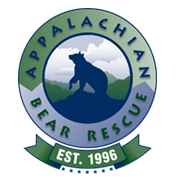 The fall of 1989 was hard on the black bears of the Smokies. A severe hard mast (nut and seed) shortage had driven them into lower elevations to look for food. The resulting bear/human conflicts left an unusually large number of orphaned cubs.
The fall of 1989 was hard on the black bears of the Smokies. A severe hard mast (nut and seed) shortage had driven them into lower elevations to look for food. The resulting bear/human conflicts left an unusually large number of orphaned cubs.
A group of dedicated volunteers decided to form Appalachian Black Bear Rehabilitation & Release Center, Inc. to help the Tennessee Wildlife Resources Agency and the Great Smoky Mountains National Park care for the orphaned cubs of the Smokies. Appalachian Bear Rescue was “born” on July 31, 1990, when these volunteers obtained a corporate charter, formed a board of directors and applied for tax exempt status, which the Internal Revenue Service granted in February of 1991.
Known then as the Appalachian Bear Center, the early years were devoted to raising money, locating land and building a fenced area to care for the bears. Volunteers dug deep trenches so the fences could be sunk several feet into the ground to prevent the bears from digging their way to freedom. In 1995-1996 dollars, the fence cost about $35,000.
Our very first bear, “Zero”, arrived on July 8, 1996 and was released on September 20, 1996. Our first full-time curator, Daryl Ratajczak, started on June 9, 1997, and promptly began caring for three yearling bears. By 1999, word of ABC’s success led other states to ask for its help. Since then Arkansas, North Carolina, Virginia, Alabama, Georgia, Louisiana, Kentucky and South Carolina have all asked ABC/ABR to help care for their severely malnourished cubs.
From 1996 through early 2012 Appalachian Bear Rescue had a total of three curators. ABR now has five curators on staff as of June 2021.
Tom Faulkner was hired as a part-time curator in late 2016. He has been part of ABR since the very beginning. He was a Board member and Facilities Manager until becoming an assistant curator.
Many improvements were made to the facility during 2012 including the addition of two storage buildings, a cub nursery, and a building for refrigerated food storage (known as the Cubby Cooler). The outdoor pens and habitats were retrofitted and safety corridors were constructed for safe and easy entrance into the enclosures.
Other improvements to the ABR facility include the construction of two additional Wild Enclosures, a Cub House for a transition from the Cub Nursery to the outdoor areas, and Acclimation Pens for each of the new Wild Enclosures. These improvements allowed us to help a total of 56 cubs and yearlings during the period from March 2015 through November 2016. Each Wild Enclosure can house up to ten cubs or yearlings. In 2015-16 we renovated the oldest building on the property, a block building that was used for storage, and converted it to a recovery center for injured cubs who are supposed not to climb (for their safety and to prevent further injury). The pens and attached outdoor area can be modified by lowering the top of the pen. The Red Roof Recovery Center has provided safe shelter for many injured yearlings and cubs.
We continue to work closely with TWRA and GSMNP officials to help black bear cubs in need.

